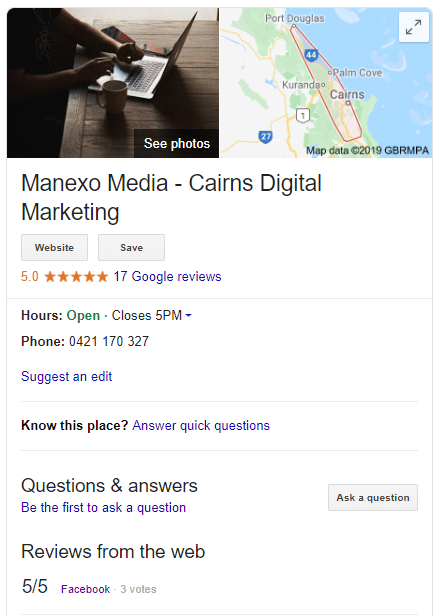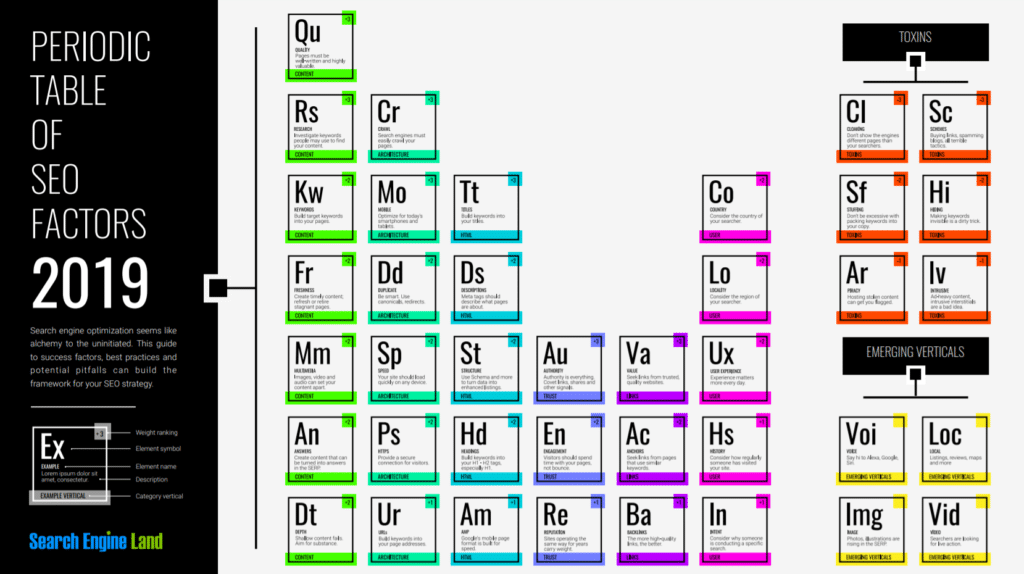
Menu
Gone are the days where you could simply list yourself in the Yellow Pages and expect people to find out who you were and what you did.
Now, anyone can create a website or listing online and take on their competition.
Search engines such as Google have levelled the playing field for businesses such as yours to easily outrank your competitors and reach more customers.
The world of Search Engine Optimisation (SEO) is massive, and yet so many business owners like yourself aren’t willing to work on it.
Local SEO is a powerful and also underutilised strategy. It allows you to improve your rankings in search engines such as Google for local search terms.
Local SEO strategies are massive for you, because whether you believe it or not, your customers are searching for your services online.
Search engines are just one stream they’re looking for you, with other beneficial places like social media or paid advertising..
They’re looking for who has the best prices, the most credibility, the most skill and experience and who do they just genuinely connect with.
So, truth be told – if you’re ranked higher in Google, you’re more likely to get more visits to your website and more potential customers.
In this article I want to give you the blueprint for outranking your competitors.
I want to tell you what to focus on if you’re serious about improving your digital marketing and outperforming your competition.
Let’s go!
Let’s start with Google My Business, as I feel it’s an easy win for people just getting started.
Your Google My Business listing is a free profile for your business on Google that legitimises that you’re a real business.
If you haven’t set one up yet, it’s really easy. Just click here, go to start now and follow the steps to add in your business details.
You’ve probably seen these profiles before when you’ve made your own searches.

It’s the business profiles that pop up in Google searches that provide information and insights into the different businesses around you.
Once you have a verified profile, your goal should be to fill out as much of the Google My Business listing as possible.
This is giving Google more information to help it rank you. The more information, the more legitimate you seem, and most customers will be able to evaluate your business.
Add in high-quality images about your business and team, add opening hours, an engaging about section, your services and more.
Also, try to get positive customer reviews on your listing. Not only do reviews help your SEO ranking, but they help build trust and credibility with your customers.
Finally, try to utilise the posts feature. This is where you can post updates such as upcoming events, special offers, or other content ideas, that will help you stand out even more to local searchers.
The majority of your website pages and blog posts are being looked at by Google and they’re determining whether you’re worth ranking in different search results.
For most business owners, they don’t make a good impression with their website because they don’t optimise the pages.
So, what should you be looking at and changing?
Start optimising your site for specific keywords and search phrases.
Your customers are entering specific words into their search boxes to look for things related to your business. These are keywords, and they’re what you want to be ranking for.
If Google believes your site is the best fit for a specific keyword or phrase, they’ll put you to the top of the search results list.
You can help Google out here by optimising your site for these keywords. However, you need to do so authentically.
This isn’t about placing the keywords you want to rank for across every corner of your website. You need to sprinkle them into the descriptions and posts across your site in a way that actually makes sense.
The easiest place to start is to think about related keywords to your industry and location.
Follow the formula, [INDUSTRY / SERVICE] + [LOCAL AREA / CITY]

For example, “Car Mechanic” + “Cairns, Australia” or, “Italian Restaurant” + “Port Douglas”
This helps Google out because you’re letting them know
Switching these up will also help. If you can put similar or related terms for your business or industry, that helps add extra weight and can help you rank for other related keywords.
The same goes with location keywords, and if you can rank for different areas around your city or business.
Next is to work on optimising each page. Simply put, you need to try to optimise the Title Tag, Meta Description, URL, Headers and Content of each page.
When I say optimise, I mean adding in relevant keywords depending on what the page is about.
For example, if you’ve created your services page try to add in keywords about that specific service and the location you operate.
If it’s a blog post about a particular topic, try to include relevant keywords around what the post is talking about.
Let’s start with the URL. This is the website address that people can enter to reach that website page.
The next area is your Page Title. This is the listed name for that specific website page or blog post.
Then you have the Meta Description. This is a short description about what that page is about, and is useful for searchers who come across your page in Google’s search results.

Finally, is your page content and headers. This is the actual content on your page that should have keywords you’re trying to rank for sprinkled throughout it.
In all of these pages, aim to include relevant keywords based on what the page is about and what keywords you’re trying to rank that page for.
Make sure they are relevant though. Don’t go placing random keywords you want to rank for that have nothing to do with the page, because it won’t reflect well for you with Google or people who visit your site.
Depending on what website builder or content management system you’re using, you’ll have different ways to do this.
For WordPress users, you can add a plugin called Yoast SEO that easily helps you work out what keywords to add and where you should be placing them on each page.
So you’ve started optimising your own site and you’ve set up a Google My Business account.
Now it’s time to claim other online listings that are available.
Having verified listings online for your business helps add weight to the legitimacy of your business in the eyes of Google and other search engines.
It also helps you build more exposure to potential customers and more opportunities to find your business.
Where should you start exactly?
Try to tick off some of the major sites that you can create a business listing on, such as: Google My Business, Bing, Google Maps, Apple, Trip Advisor, Yelp and more.
Try to keep the information consistent across all of these places, such as your Business Name, your Address and your Phone Number.
These details should also be consistent with those that are on your own website.
Next is online directories. There are a number of free online directories that you can list your business that will help improve your ranking.

There are likely national websites you can list on for free, such as True Local or Yellow Pages.
Or, there might be area specific directories you can rank on also, such as The Cairns Hub or Cairns Local.
Finally, don’t forget any other directories, clubs or memberships you’re a part of. This includes Chambers of Commerce or other community groups that will list your business.
Ensure each of these profiles is filled out with relevant keywords, consistent contact details, and engaging descriptions about your business.
Content has become a powerful ranking factor for businesses in search engines. It can help you organically generate more awareness and leads for your business.
This makes sense because search engines are trying to serve users the most relevant content to what they’re looking for.
It also makes sense because most users are searching for answers to their problems.
Creating high-quality content that helps your target audience answer specific questions or solve key problems they’re having is a powerful way to rank higher.
This is because if your content is meaningful and valuable to those people searching for it, Google will be more inclined to rank it higher in their search results.
What would your target audience be looking for related to your area? If you run a Gym for example there may be a few options.
First, you could create service related pieces of content. This might be something such as Cycling Classes Available in Cairns, Australia. You could then talk about the benefits of cycling classes and what yours offers.
Or, you could create informative content related to your audience. How To Stay Fit While Living in Far North Queensland. This could be some helpful advice on staying fit, and tying in relevant information for local people.
Finally, you could create content that isn’t necessarily related to your gym, but might still appeal to your audience. The Top 5 Walking Tracks in Cairns, Australia. This would reach a broader group of people, but some people in your area who want to stay fit and go to the gym probably also like going on hikes.
See how different types of blog posts and content on your website can help you rank for different topics.
By using the above pieces of content that gym may now rank for keywords relating to “Cycling Classes in Cairns”, “Staying Fit in Far North Queensland” and “Walking Tracks in Cairns Australia”
Each of those probably has a fair few number of searches and is helping them improve their overall SEO performance.
Remember the periodic table from school? It would list all the different chemical elements ranked together.
My final piece of advice to you is to look into the SEO Periodic Table.
This is a table, similar to the chemical periodic table, that ranks all the different SEO factors that influence your search engine ranking.
It’s a helpful resource for someone like yourself who wants to know which areas will help you improve your ranking or hurt your ranking.
Each factor on this table has a different number, either positive or negative, and relates to how it influences your ranking.
For example, pages with well written, high-quality content have a factor of +3. Compare this to stealing other people’s content which has a factor of -1.

The Periodic Table of SEO Factors 2019 | Source: Search Engine Land
This is just a reference guide to help you understand the impact of different tactics you can use moving forward.
Overall, SEO for local businesses can seem like a lot. However, with small steps each week and improving each little factor, you can outrank and overtake your local competitors online.
By starting today with the strategies I’ve talked about and working on them each week, you’ll watch your ranking improve and the number of visitors to your site increase.
© 2021 All rights reserved
Manexo Media